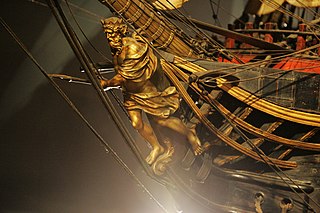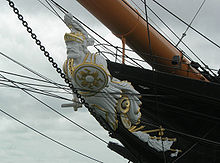Figurehead (object)

Afigureheadis a carved wooden decoration found at thebowofships,generally of a design related to the name or role of a ship. They were predominant between the sixteenth and twentieth centuries, and modernships' badgesfulfil a similar role.
History[edit]

Early ships often had some form of bow ornamentation (e.g. the eyes painted on the bows ofGreekandPhoeniciangalleys,the Roman practice of putting carvings oftheir deitieson the bows of their galleys, and theViking shipsof ca. A.D. 800–1100). The menacing appearance of toothy and bug-eyed figureheads on Viking ships were considered a form ofapotropaic magic,serving the function of warding offevil spirits.[1]
The Ancient Egyptians placed figures of holy birds on the prow. A wall relief at Medinet Habu depicting Ramses III defeating the Sea Peoples in theBattle of the Nile Deltacirca 1200 BC depicts Ancient Egiptian ships with a fierce lioness figurehead carved on the bow of two of the ships. Likely this depicted their warrior goddess,Sekhmet,who was seen as their protector. The Phoenicians used horses representing speed. The Ancient Greeks used the heads of boars to symbolise acute vision and ferocity while Roman boats often mounted a carving of a centurion representing valour in battle. In northern Europe, serpents, bulls, dolphins, and dragons were customary and by the thirteenth century, the swan was used representing grace and mobility.[2]
In Germany, Belgium, and the Netherlands, it was once believed that spirits or faeries calledKaboutermannekes(gnomes, little men, faeries) dwelt in the figureheads. The spirit guarded the ship from sickness, rocks, storms, and dangerous winds. If the ship sank, theKaboutermannekesguided the sailors' souls to the Land of the Dead. To sink without aKaboutermannekecondemned the sailor's soul to haunt the sea forever, so Dutch sailors believed. A similar belief was found in early Scandinavia.[citation needed]

In pre-colonial Burma, during theKonbaung dynasty,figureheads were used to distinguish several types ofroyal bargesallocated to different members of the royal court; each barge had a specific mythical figurehead at the front.
A general practice of figureheads was introduced in Europe with thegalleonsof the sixteenth century, as the figurehead as such could not come to be until ships had astemheadstructure on which to place it.[3]During the period from the seventeenth to the eighteenth centuries the carved subjects of figureheads varied from representations of saints to patriotic emblems such as the unicorns or lions popular on British ships. When the ship was named after a royal or naval personage the head and bust of the individual might be shown.[4]
As with the stern ornamentation, the purpose of the figurehead was often to indicate the name of the ship in a non-literate society (albeit in a sometimes very convoluted manner); and always, in the case of naval ships, to demonstrate the wealth and might of the owner. At the height of theBaroqueperiod, some ships boasted gigantic figureheads, weighing several tons and sometimes twinned on both sides of the bowsprit.[citation needed]
A large figurehead, being carved from massive wood and perched on the very foremost tip of the hull, adversely affected the sailing qualities of the ship. This, and cost considerations, led to figureheads being made dramatically smaller during the eighteenth century, and in some cases they were abolished altogether around 1800. After theNapoleonic warsthey made something of a comeback, but were then often in the form of a small waist-up bust rather than the oversized full figures previously used. Theclipperships of the 1850s and 1860s customarily had full figureheads, but these were relatively small and light. During their final stage of common use figureheads ranged in length from about 18 inches (46 cm) to 9 feet (2.7 m).[5]
Decline in use[edit]
This sectionneeds additional citations forverification.(November 2017) |




Figureheads as such died out with the military sailing ship. In addition the vogue forram bowsmeant that there was no obvious place to mount one on battleships.[6]An exception wasHMSRodneywhich was the last British battleship to carry a figurehead.[6]Smaller ships of the Royal Navy continued to carry them. The last example may well have been the sloopHMSCadmuslaunched in 1903.[7]Her sister shipEspieglewas the last to sport a figurehead until her breaking up in 1923. Early steamships sometimes had gilt scroll-work and coats-of-arms at their |bows. This practice lasted up until aboutWorld War I.The 1910 German linerSSImperatororiginally sported a large bronze figurehead of an eagle (the Imperial German symbol) standing on a globe. The few extra feet of length added by the figurehead madeImperatorthe longest ship in the world at the time of her launch.
It is still common practise for warships to carryships' badges,large plaques mounted on the superstructure with a unique design relating to the ship's name or role. For example,Type 42 destroyersof theRoyal Navy,which are named after British cities, carry badges depicting thecoat of armsof their namesake.
On smaller vessels, abilletheadmight be substituted. This was a smaller, nonfigural carving, most often a curl of foliage.[8][9]
Images[edit]

-
The bow and the figurehead ofLa RecouvranceinBrest
-
Figurehead of theSeute Deern
-
BAPUnión.Close-up view of theInca Yupanquisculpture.
-
The figurehead of British clipper shipCutty Sark(1869) depicted the legendary witch from which she was named, and included a horse's tail as told in the legend.
-
Gibraltarin 1896
See also[edit]
References[edit]
- ^British Museum,Viking Ship's Figurehead,found inEast Flanders
- ^"Ship's figureheads".Research.Royal Naval Museum Library. 2000.Retrieved2013-08-16.
- ^Stackpole, Edouard A. (1964).Figureheads & ship carvings at Mystic Seaport.Marine Historical Association.Retrieved2012-11-14.
- ^Pages 132-133 Volume IV, Micropaedia Encyclopaedia Britannica, 15th Edition
- ^Page 132 Volume IV, Micropaedia Encyclopaedia Britannica, 15th Edition
- ^abcLambert, Andrew(1987).Warrior Restoring the World's First Ironclad.Conway maritime press. p. 152.ISBN0-85177-411-3.
- ^Preston, Antony;Major, John (2007).Send a Gunboat The Victorian Navy and Supremacy at Sea, 1854–1904.Conway Maritime. p. 120.ISBN978-0-85177-923-2.
- ^"Terminology from the Age of Sail: Billethead".
- ^"Billethead from Ship" Favorite "".National Gallery of Art.Retrieved2012-11-14.
External links[edit]
- The Figurehead Archive
- Telegraph Gallery (17 images)
- History Trust of South Australia
- Figureheads
- The Mariners' Museum Figurehead Collection
- Winchester, Clarence, ed. (1937),"Ships' figureheads",Shipping Wonders of the World,pp. 776–780
- Figureheads from the Vestfold Museums's (Norwegian) collections on DigitalMuseum
Further reading[edit]
- Pulvertaft, David (2011).Figureheads of the Royal Navy.Foreword by Admiral the Lord Boyce. Barnsley, S. Yorkshire: Seaforth Publishing.ISBN978-1-84832-101-4.



![Figurehead of the Seute Deern [de]](https://upload.wikimedia.org/wikipedia/commons/thumb/e/e5/Seute_deern_figurehead.JPG/120px-Seute_deern_figurehead.JPG)



